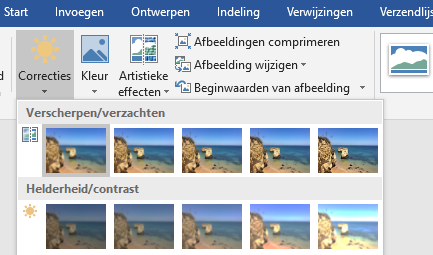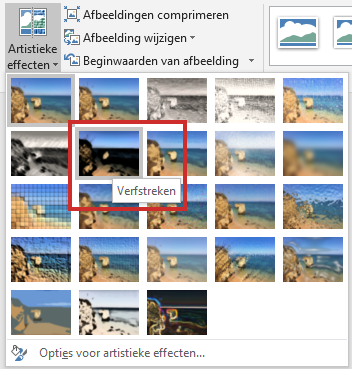
Make a Word document attractive with images. In this article, you will learn how to work with images in Word 2016.
Which Word version?
Word 2016 is available for purchase as part of the Office 2016 package and as part of the Office 365 online package. This article was written using Word 2016 in Office 365. Not familiar with Word 2016 yet? Then we recommend that you first read the article ‘Word: the basics (Word 2016)’.
- Do you have Word 2019? Then read the article ‘Word: images (Word 2019)’.
- Do you have Word 2013? Then read the article ‘Word: images (Word 2013)’.
- Do you have Word 2010? Then read the article ‘Word: images (Word 2010)’.
Article structure
Word 2016 distinguishes between images and other illustrations. In this article, we’ll only cover inserting and editing images and photos that are already on your computer. Below you can read how to proceed; from inserting an image to applying the most commonly used editing options.
You can read about the other artwork options in Word in the “Draw with Word” article.
Step 1: Insert a picture
You can insert all kinds of images into Word, such as digital photos or pictures that you have obtained from the Internet. You do this as follows:
- In the Word document, click where you want to insert a picture.
- In the Ribbon, click on the tab Insert.
- Press the button Pictures.
- Scroll to the desired image and click on it.
- click on Insert.
The image you chose is now in the document. A new tab has been added to the Ribbon: ‘Picture Tools – Format’. It contains functions to edit the image.
Step 2: Buttons on the Format tab
You can adjust the image you have inserted in Word. For basic operations, such as resizing, this is excellent. If you want to perform multiple or advanced edits, such as straightening the horizon or removing red-eye, you must first edit your photos in a photo editing program.
The various image editing functions become active in Word when you click on the inserted image. If you click elsewhere in the document, the ‘Format’ tab disappears. It will return if you click on the image again.
On the ‘Format’ tab, you will find different groups of formatting options from left to right.
- In the first group ‘Adjust’, you will find buttons for ‘Remove Background’, ‘Corrections’, ‘Color’ and ‘Artistic Effects’.
- In addition, you will find the ‘Picture Styles’ group. Here are options with which you can, for example, give the image a border.
- You control the position of the image in the ‘Arrange’ or ‘Arrange’ group.
- You can reduce and crop the image in the ‘Size’ group on the far right.
Below we’ll get started with a few commonly used options.
Step 3: Adjust brightness, contrast and sharpness
Use the ‘Corrections’ button to make a photo sharper or softer. You can also adjust the brightness (lighter and darker) and the contrast between the colors in one operation.
- In the ‘Edit’ group, click Corrections and mouse over the examples under ‘Sharpen and soften’. You can see the effect on the photo in the document. Click on the option you are happy with.
- In the ‘Edit’ group, click Corrections and mouse over the examples under ‘Brightness and contrast’. Here too you can see the effect of an option and you can click on the one that seems best to you.

Step 4: Adjust the colors
With the ‘Color’ button you can adjust the color saturation and hue of a photo and even choose a completely different color that is layered over the photo.
- In the ‘Edit’ group, click Colour.

- Choose one of the options. Hover over it and you will see the name and effect on your photo. For example, click Sepia for a photo with a nostalgic touch.
- In the same window you can choose even more colors under ‘More variations’. Whenever you hover your mouse over an option, you will see the result in the photo. When you like the color, click on it.
Step 5: Add an Effect
With the button ‘Artistic effects’ you give a special effect to the photo.
- In the ‘Edit’ group, click Artistic Effects.
- Click on one of the options, for example Paint strokes.

Step 6: Back to Original
Have you experimented, but would you rather have the original photo back? This can be done as follows:
- Is the image no longer selected? Then click on it
- The ‘Format’ tab appears in the Ribbon. Click here.
- In the ‘Edit’ group, click Image Initials
 .
.
Step 7: (move) the image
To place the image in the correct position in the text, do the following:
- In the ‘Arrange’ or ‘Arrange’ group, click the button Position.

- You choose one of the options to change the position of the image. The image can be on the left, right, bottom, top, or center of the text. By the way, you can also move a picture by clicking and dragging it while holding down the mouse button.
- Do you want to put the image behind the text? In the ‘Arrange’ group, click Text wrapping > Behind text.
Step 8: Adjust the Size
- Adjust the number of centimeters (height and width) in the right group ‘Size’ with the small arrows.
- Or click on the picture. A frame border and circles appear around the image. Click a circle in one of the corners and hold down the mouse button while dragging the mouse to make the image wider or taller.

Step 9: Crop the Image
- Click in the right group ‘Size’ on crop > crop.
- Black bars and corners appear around the image. Move the mouse pointer over it.
- When the mouse pointer changes to a black bar or corner, click and hold the left mouse button.
- Move the pointer inward to crop the image.
- If necessary, undo the cropping by dragging the black bar or corner back out.
- Press the Enter key when you are satisfied.
- Unsatisfied? Use the shortcut Ctrl+Z to undo the action.